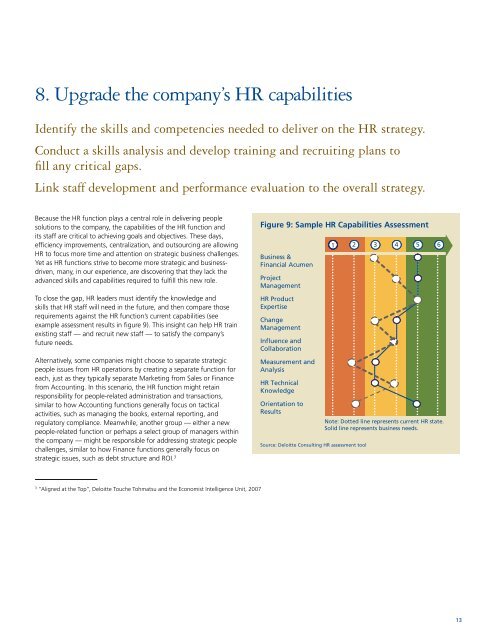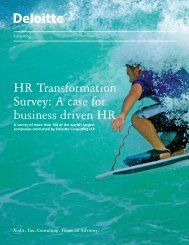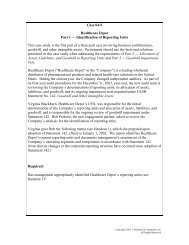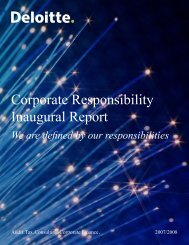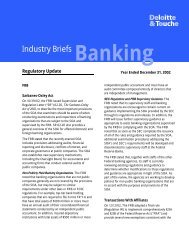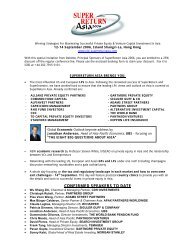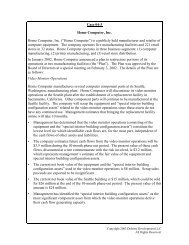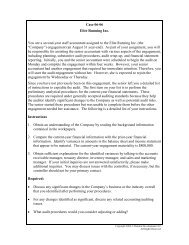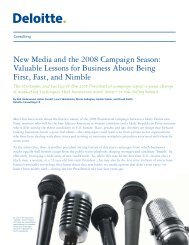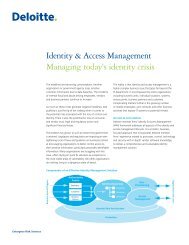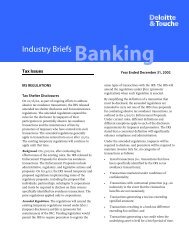Taking HR to the next level - Deloitte
Taking HR to the next level - Deloitte
Taking HR to the next level - Deloitte
- No tags were found...
You also want an ePaper? Increase the reach of your titles
YUMPU automatically turns print PDFs into web optimized ePapers that Google loves.
8. Upgrade <strong>the</strong> company’s <strong>HR</strong> capabilitiesIdentify <strong>the</strong> skills and competencies needed <strong>to</strong> deliver on <strong>the</strong> <strong>HR</strong> strategy.Conduct a skills analysis and develop training and recruiting plans <strong>to</strong>fill any critical gaps.Link staff development and performance evaluation <strong>to</strong> <strong>the</strong> overall strategy.Because <strong>the</strong> <strong>HR</strong> function plays a central role in delivering peoplesolutions <strong>to</strong> <strong>the</strong> company, <strong>the</strong> capabilities of <strong>the</strong> <strong>HR</strong> function andits staff are critical <strong>to</strong> achieving goals and objectives. These days,efficiency improvements, centralization, and outsourcing are allowing<strong>HR</strong> <strong>to</strong> focus more time and attention on strategic business challenges.Yet as <strong>HR</strong> functions strive <strong>to</strong> become more strategic and businessdriven,many, in our experience, are discovering that <strong>the</strong>y lack <strong>the</strong>advanced skills and capabilities required <strong>to</strong> fulfill this new role.To close <strong>the</strong> gap, <strong>HR</strong> leaders must identify <strong>the</strong> knowledge andskills that <strong>HR</strong> staff will need in <strong>the</strong> future, and <strong>the</strong>n compare thoserequirements against <strong>the</strong> <strong>HR</strong> function’s current capabilities (seeexample assessment results in figure 9). This insight can help <strong>HR</strong> trainexisting staff — and recruit new staff — <strong>to</strong> satisfy <strong>the</strong> company’sfuture needs.Alternatively, some companies might choose <strong>to</strong> separate strategicpeople issues from <strong>HR</strong> operations by creating a separate function foreach, just as <strong>the</strong>y typically separate Marketing from Sales or Financefrom Accounting. In this scenario, <strong>the</strong> <strong>HR</strong> function might retainresponsibility for people-related administration and transactions,similar <strong>to</strong> how Accounting functions generally focus on tacticalactivities, such as managing <strong>the</strong> books, external reporting, andregula<strong>to</strong>ry compliance. Meanwhile, ano<strong>the</strong>r group — ei<strong>the</strong>r a newpeople-related function or perhaps a select group of managers within<strong>the</strong> company — might be responsible for addressing strategic peoplechallenges, similar <strong>to</strong> how Finance functions generally focus onstrategic issues, such as debt structure and ROI. 3Figure 9: Sample <strong>HR</strong> Capabilities AssessmentBusiness &Financial AcumenProjectManagement<strong>HR</strong> ProductExpertiseChangeManagementInfluence andCollaborationMeasurement andAnalysis<strong>HR</strong> TechnicalKnowledgeOrientation <strong>to</strong>ResultsSource: <strong>Deloitte</strong> Consulting <strong>HR</strong> assessment <strong>to</strong>ol1 2 3 4 5 6Note: Dotted line represents current <strong>HR</strong> state.Solid line represents business needs.3“Aligned at <strong>the</strong> Top”, <strong>Deloitte</strong> Touche Tohmatsu and <strong>the</strong> Economist Intelligence Unit, 200713


